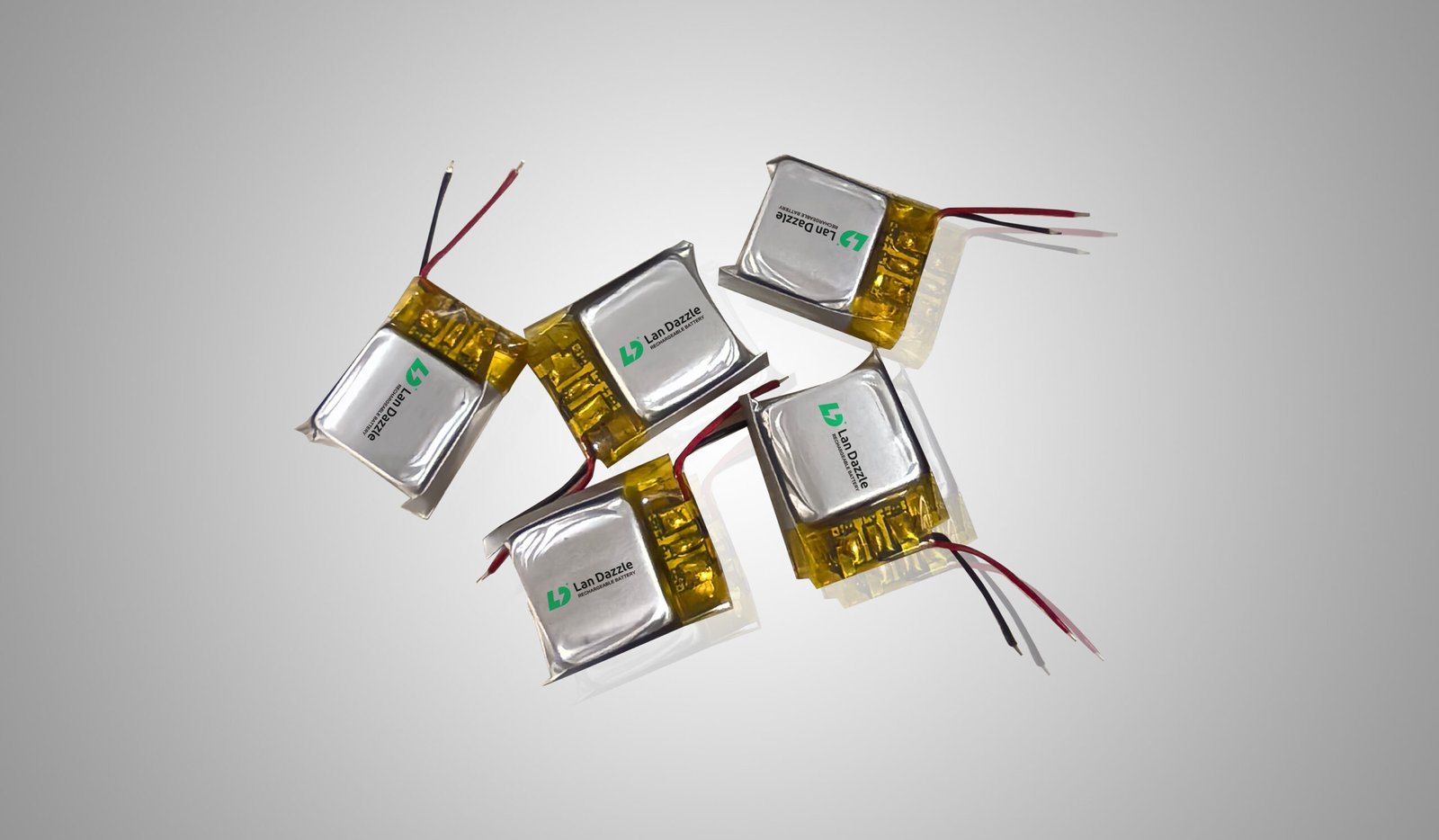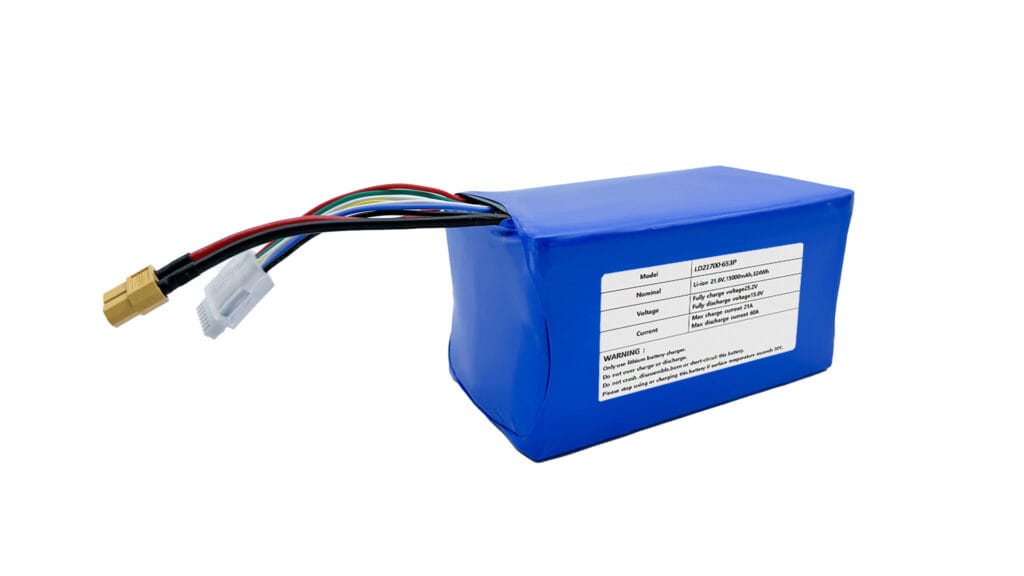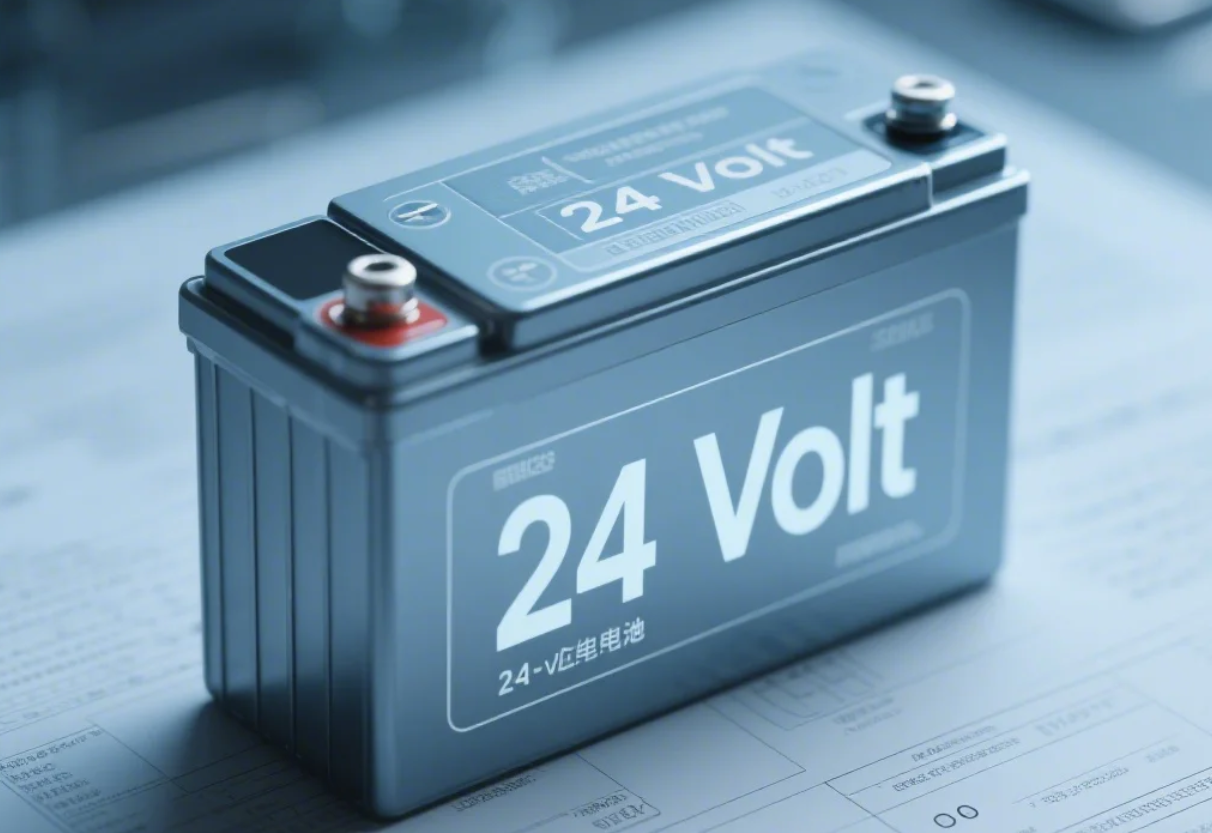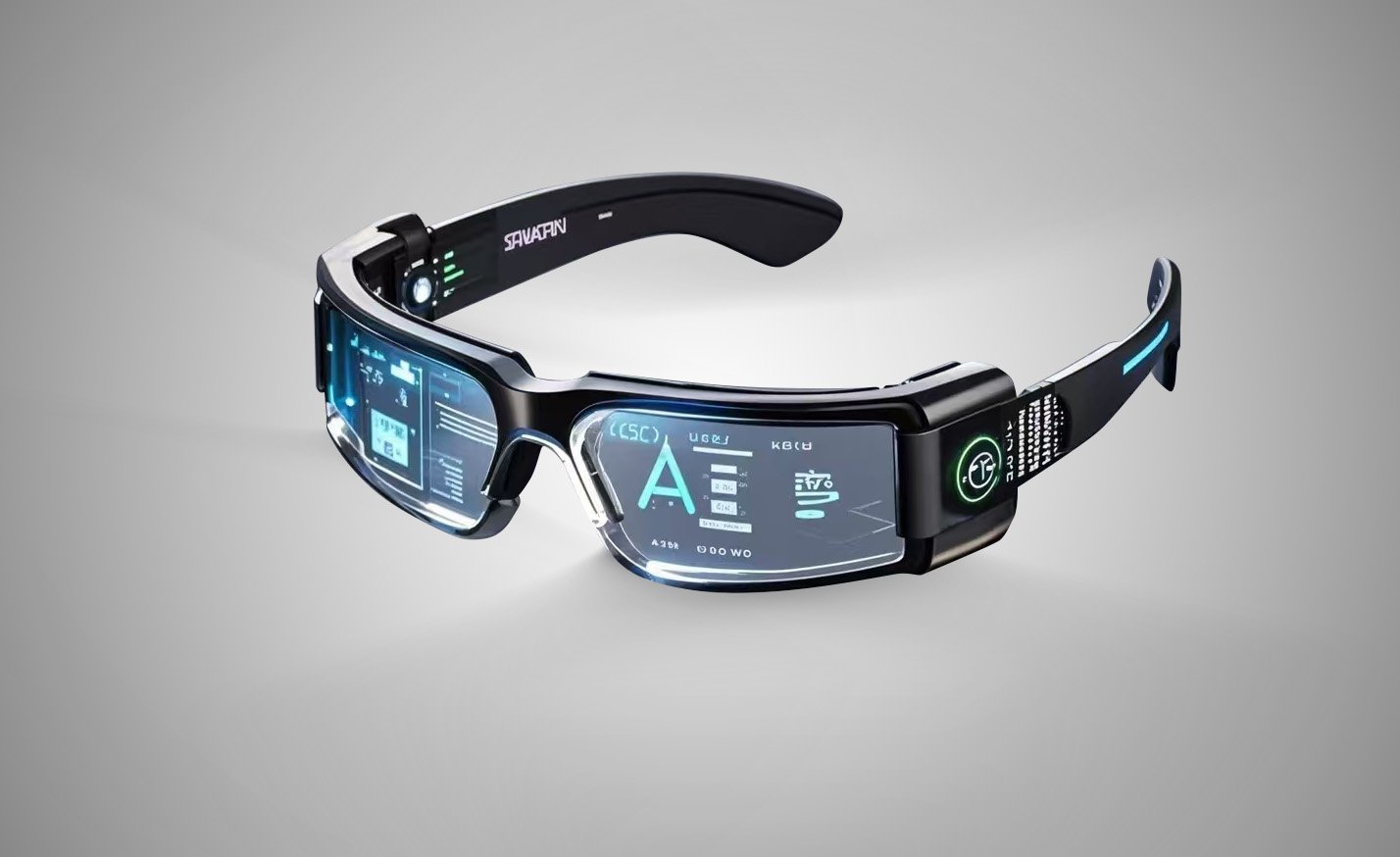Od eleganckiego smartwatcha na nadgarstku śledzącego parametry życiowe po dyskretny aparat słuchowy poprawiający wrażenia słuchowe, technologia do noszenia płynnie zintegrowała się z naszym codziennym życiem. Te kompaktowe cuda, wykonujące coraz bardziej wyrafinowane zadania, wszystkie opierają się na cichym koniu roboczym: małej baterii litowo-jonowej. Ten artykuł zagłębia się w świat małych baterii litowo-jonowych, badając ich dominację, kluczowe kwestie, przyszłe trendy i sposoby maksymalizacji ich żywotności.
Mała bateria litowo-jonowa do urządzeń ubieralnych
Akumulator litowo-jonowy składa się z kilku kluczowych komponentów współpracujących ze sobą w celu wytworzenia energii elektrycznej. Są to anoda, zwykle wykonany z grafitu, przechowuje jony litu podczas ładowania akumulatora. W katodaczęsto tlenek metalu, taki jak tlenek litowo-kobaltowy (LCO) lub fosforan litowo-żelazowy (LiFePO4), uwalnia jony litu podczas rozładowywania. An elektrolit, medium chemiczne, ułatwia przepływ tych naładowanych jonów między anodą a katodą. Cienka, porowata warstwa separator zapobiega bezpośredniemu kontaktowi fizycznemu między elektrodami, co ma kluczowe znaczenie dla zapobiegania zwarciom i zapewnienia bezpieczeństwa. Wreszcie, kolektory prądu (cienkie metalowe folie) przewodzą prąd elektryczny z akumulatora.
W przypadku urządzeń do noszenia, komponenty te są często konfigurowane w kompaktowych obudowach, takich jak komórki woreczkaktóre są lekkie i mogą być kształtowane tak, aby pasowały do różnych konstrukcji urządzeń, lub ogniwa pryzmatyczneoferując sztywniejszą strukturę. W niektórych mniejszych urządzeniach, takich jak aparaty słuchowe lub proste czujniki, ogniwa monetowe mogą być wykorzystane. Integralną częścią bezpiecznego i wydajnego działania tych akumulatorów jest System zarządzania akumulatorem (BMS)Układ elektroniczny, który monitoruje i kontroluje procesy ładowania i rozładowywania, zapobiegając przeładowaniu, nadmiernemu rozładowaniu i przegrzaniu.
Kluczowe kwestie przy wyborze baterii do urządzeń ubieralnych
Wybór odpowiedniej baterii litowo-jonowej do urządzenia do noszenia wymaga delikatnej równowagi między kilkoma krytycznymi czynnikami:
- Gęstość energii: Mierzona w watogodzinach na litr (Wh/L) lub watogodzinach na kilogram (Wh/kg), wyższa gęstość energii pozwala na mniejsze, lżejsze baterie o dłuższym czasie pracy - co jest znaczącą zaletą dla komfortu użytkownika i estetyki urządzenia.
- Rozmiar i forma: Urządzenia do noszenia mają różne kształty i rozmiary, co wymaga baterii, które mogą dostosować się do tych często skomplikowanych projektów. Elastyczność baterie litowo-polimerowe (LiPo) sprawia, że szczególnie dobrze się do tego nadają.
- Żywotność baterii: Zadowolenie użytkownika zależy w dużej mierze od tego, jak długo urządzenie do noszenia może działać na jednym ładowaniu. Na żywotność baterii wpływa jej pojemność (mierzona w miliamperogodzinach, mAh) i zużycie energii przez komponenty urządzenia. Na przykład smartwatche mogą przedkładać funkcje nad wydłużoną żywotność baterii, która zazwyczaj wynosi 1-3 dniPodczas gdy prostsze urządzenia do monitorowania kondycji mogą często wytrzymać tydzień lub dłużej.
- Bezpieczeństwo: Biorąc pod uwagę, że urządzenia wearables są noszone blisko ciała, bezpieczeństwo jest najważniejsze. Nowoczesne baterie litowo-jonowe posiadają różne funkcje bezpieczeństwa i certyfikaty, takie jak UL 2054 i IEC 62133 zapewniają standardy bezpieczeństwa. System BMS odgrywa kluczową rolę w zapobieganiu niebezpiecznym warunkom.
- Cykl życia: Liczba cykli pełnego naładowania i rozładowania akumulatora przed znacznym spadkiem jego pojemności. jest kluczowym czynnikiem wpływającym na żywotność urządzenia. Większość baterii do noszenia oferuje cykl życia wynoszący od kilkuset do ponad tysiąca cykli.
- Czas i metody ładowania: Ważna jest również wygoda ładowania. Podczas gdy ładowanie przewodowe pozostaje powszechne, ładowanie bezprzewodowe jest coraz częściej stosowane ze względu na łatwość użytkowania. Technologie szybszego ładowania są również stale rozwijane.
Różne rodzaje baterii litowo-jonowych stosowanych w urządzeniach ubieralnych
Podczas gdy podstawowe zasady pozostają takie same, różne chemikalia litowo-jonowe oferują różne właściwości, które sprawiają, że nadają się do określonych zastosowań do noszenia:
- Polimer litowy (LiPo): Wykorzystując żelowy elektrolit, akumulatory LiPo oferują wyjątkową elastyczność projektowania, umożliwiając formowanie ich w cienkie i niestandardowe kształty, idealne do konturów urządzeń do noszenia, takich jak opaski fitness i zakrzywione smartwatche. Generalnie zapewniają dobrą gęstość energii i są lekkie.
- Tlenek litowo-kobaltowy (LCO): Znane ze swojej wysokiej gęstości energii, baterie LCO są często spotykane w mniejszych urządzeniach do noszenia, gdzie maksymalizacja mocy w ograniczonej przestrzeni ma kluczowe znaczenie, takich jak kompaktowe smartwatche. Mogą one jednak charakteryzować się niższą stabilnością termiczną w porównaniu z niektórymi innymi materiałami chemicznymi.
- (Mniej powszechne, ale pojawiające się): Akumulatory litowo-żelazowo-fosforanowe (LiFePO4) oferują doskonałą stabilność termiczną i długą żywotność, dzięki czemu są potencjalnie odpowiednie dla urządzeń medycznych lub aplikacji, w których bezpieczeństwo i trwałość są ważniejsze niż bezwzględna gęstość energii.
Wybór składu chemicznego baterii zależy od konkretnych wymagań urządzenia do noszenia, równoważąc czynniki takie jak rozmiar, waga, gęstość energii, bezpieczeństwo i koszt.
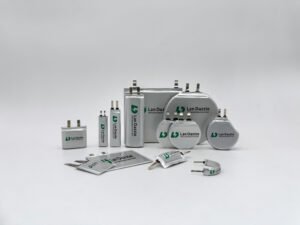
Znaczenie systemów zarządzania bateriami w urządzeniach ubieralnych
System zarządzania baterią jest niedocenianym strażnikiem baterii litowo-jonowej w urządzeniu do noszenia. Ten zaawansowany obwód elektroniczny wykonuje kilka krytycznych funkcji, aby zapewnić bezpieczne i optymalne działanie:
- Ochrona przed przeładowaniem: Zapobiega ładowaniu akumulatora powyżej jego maksymalnego napięcia, co może prowadzić do przegrzania, uszkodzenia, a nawet pożaru.
- Ochrona przed nadmiernym rozładowaniem: Zapobiega rozładowaniu baterii poniżej jej minimalnego napięcia, co może spowodować nieodwracalne uszkodzenia i skrócić jej żywotność.
- Zabezpieczenie nadprądowe: Ogranicza ilość prądu pobieranego z akumulatora, zapobiegając przegrzaniu i potencjalnym uszkodzeniom spowodowanym nadmiernym obciążeniem.
- Monitorowanie temperatury: Stale monitoruje temperaturę akumulatora i może przerwać ładowanie lub rozładowywanie, jeśli przekroczy ona bezpieczne limity.
- Równoważenie ogniw (w zestawach z wieloma ogniwami, rzadziej w bardzo małych urządzeniach do noszenia, ale zasada jest istotna): Zapewnia równomierne ładowanie i rozładowywanie wszystkich ogniw w akumulatorze, maksymalizując ogólną pojemność i żywotność akumulatora.
Postępy w technologii BMS odegrały kluczową rolę w poprawie bezpieczeństwa i niezawodności baterii litowo-jonowych w urządzeniach do noszenia, umożliwiając tworzenie bardziej wydajnych i bogatych w funkcje urządzeń bez narażania bezpieczeństwa użytkownika.
Przyszłe trendy i innowacje w dziedzinie baterii do urządzeń ubieralnych
Poszukiwanie jeszcze lepszych źródeł zasilania dla urządzeń wearables trwa, a na horyzoncie pojawia się kilka obiecujących trendów:
- Baterie półprzewodnikowe: Zastąpienie ciekłego elektrolitu elektrolitem stałym zapewnia większe bezpieczeństwo, wyższą gęstość energii i potencjalnie dłuższą żywotność. Technologia półprzewodnikowa, choć wciąż w fazie rozwoju do powszechnego użytku w małych urządzeniach do noszenia, ma ogromny potencjał.
- Elastyczne i rozciągliwe baterie: W miarę jak urządzenia do noszenia stają się coraz bardziej zintegrowane i dopasowane do ludzkiego ciała, zapotrzebowanie na elastyczne, a nawet rozciągliwe baterie będzie rosło. Prototypy takich baterii już powstają, torując drogę do prawdziwie płynnej integracji.
- Zbieranie energii: Zdolność do pozyskiwania energii z otoczenia, takiej jak ciepło ciała, ruch (energia kinetyczna) lub światło otoczenia, może uzupełnić lub nawet częściowo zastąpić tradycyjne baterie w urządzeniach ubieralnych o niskim poborze mocy, wydłużając ich czas pracy lub zmniejszając potrzebę częstego ładowania.
- Zaawansowany system BMS: Przyszłe systemy BMS będą prawdopodobnie zawierać bardziej zaawansowane algorytmy i sztuczną inteligencję, aby zoptymalizować zużycie energii w oparciu o zachowanie użytkownika i kontekst urządzenia, jeszcze bardziej wydłużając żywotność baterii i poprawiając ogólną wydajność.
Dbanie o baterię urządzenia do noszenia: Wskazówki dotyczące długowieczności
Chociaż technologia jest stale ulepszana, odpowiednia pielęgnacja może znacznie wydłużyć żywotność baterii urządzenia do noszenia:
- Należy unikać ekstremalnych temperatur: Wystawienie urządzenia na działanie bardzo wysokich lub bardzo niskich temperatur może negatywnie wpłynąć na wydajność i żywotność baterii.
- Należy używać zalecanej ładowarki: Korzystanie z ładowarki zaprojektowanej specjalnie dla danego urządzenia zapewnia prawidłowe napięcie i natężenie prądu.
- Proszę unikać głębokich wyładowań: Podczas gdy nowoczesne akumulatory litowo-jonowe nie cierpią z powodu "efektu pamięci" starszych technologii, konsekwentne rozładowywanie akumulatora do zera może z czasem powodować jego obciążenie. Częściowe rozładowania są generalnie lepsze.
- Przechowywanie z częściowym naładowaniem: Jeśli planujesz przechowywać swoje urządzenie do noszenia przez dłuższy czas, najlepiej pozostawić baterię naładowaną do około 50%.
- Proszę aktualizować oprogramowanie: Producenci często wydają aktualizacje oprogramowania, które zawierają ulepszenia optymalizacji baterii.
Wnioski
Niewielkie baterie litowo-jonowe są cichym czynnikiem umożliwiającym rozwój rynku technologii ubieralnych. Ich wysoka gęstość energii, lekkość i stosunkowo długi cykl życia sprawiły, że stały się one preferowanym źródłem zasilania dla szerokiej gamy urządzeń, które poprawiają nasze zdrowie, komunikację i codzienne życie. Ponieważ zapotrzebowanie na bardziej wyrafinowane i płynnie zintegrowane urządzenia do noszenia nadal rośnie, kluczowe znaczenie będą miały ciągłe innowacje w technologii akumulatorów, szczególnie w obszarach takich jak akumulatory półprzewodnikowe i elastyczne.
Lan Dazzle specjalizuje się w niestandardowych kształtach baterii polimerowych zgodnie z potrzebami i wymaganiami firm, jeśli szukasz rozwiązań bateryjnych, które idealnie pasują do Twojego projektu, skontaktuj się z nami pod adresem info@landazzle.com lub proszę odwiedzić landazzle.com.
FAQ: Małe baterie litowo-jonowe w urządzeniach ubieralnych
-
Jak długo zwykle wystarcza bateria w typowym smartwatchu lub monitorze fitness?
- Odpowiedź: Żywotność baterii różni się znacznie w zależności od urządzenia, jego funkcji i wzorców użytkowania. Smartwatche mogą działać od 1 do 3 dni na jednym ładowaniu, podczas gdy prostsze urządzenia do monitorowania kondycji mogą często działać od 5 do 7 dni lub nawet dłużej. Czynniki takie jak jasność ekranu, korzystanie z GPS i częstotliwość powiadomień mogą mieć wpływ na zużycie baterii.
-
Czy pozostawienie urządzenia do noszenia ładującego się przez noc jest bezpieczne?
- Odpowiedź: Nowoczesne urządzenia do noszenia i ich baterie litowo-jonowe są zazwyczaj wyposażone w systemy zarządzania baterią (BMS), które zapobiegają przeładowaniu. Gdy bateria osiągnie 100%, proces ładowania zwykle się zatrzymuje. Aby jednak zmaksymalizować żywotność baterii w dłuższej perspektywie, niektórzy producenci zalecają odłączenie urządzenia po jego pełnym naładowaniu.
-
Czy mogę samodzielnie wymienić baterię w moim smartwatchu lub monitorze fitness?
- Odpowiedź: W wielu nowoczesnych urządzeniach do noszenia bateria jest zintegrowana i nie jest przeznaczona do łatwej wymiany przez użytkownika. Urządzenia są często uszczelnione pod kątem wodoodporności, co sprawia, że wymiana baterii jest skomplikowanym procesem, który może potencjalnie uszkodzić urządzenie. Zwykle zaleca się skontaktowanie się z producentem lub autoryzowanym centrum serwisowym w celu wymiany baterii.
-
Jakie czynniki mogą skrócić żywotność baterii mojego urządzenia wearable?
- Odpowiedź: Do degradacji akumulatora litowo-jonowego z czasem może przyczynić się kilka czynników. Obejmują one narażenie na ekstremalne temperatury (zarówno gorące, jak i zimne), stałe rozładowywanie baterii do bardzo niskiego poziomu, korzystanie z niecertyfikowanych ładowarek oraz naturalny proces starzenia się samej baterii.
-
Czy istnieją różne rodzaje baterii litowo-jonowych stosowanych w urządzeniach ubieralnych i czy mają one różną żywotność?
- Odpowiedź: Tak, urządzenia do noszenia powszechnie wykorzystują baterie litowo-polimerowe i baterie litowo-kobaltowe. Chociaż podstawowa chemia jest podobna, baterie LiPo są znane ze swojej elastycznej formy, a LCO z wysokiej gęstości energii. Żywotność (cykl życia) może się nieznacznie różnić między różnymi typami i producentami, ale ogólnie rzecz biorąc, dobrze utrzymana bateria litowo-jonowa w urządzeniu do noszenia powinna wystarczyć na kilka lat regularnego użytkowania.
